Immerse yourself in the divine melodies of the Bible, where the harp's strings resonate with ancient tales and celestial mysteries.
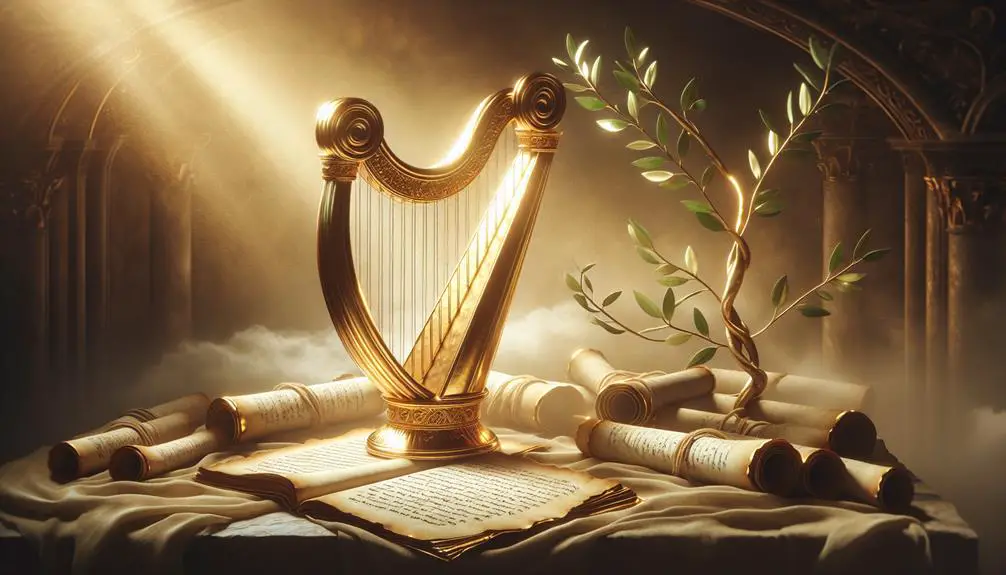
Harps in the Bible
Did you know that the harp is mentioned over 50 times in the Bible? This instrument holds a special place not only in the history of music but also in the spiritual narratives of ancient texts. From King David's legacy, who's often depicted with a harp, to its symbolism of joy and worship, the harp's presence weaves a fascinating thread through biblical stories.
But what might surprise you even more is its role in heavenly visions and the cultural impact it has had throughout the ages. Let's explore the layers of meaning behind this iconic instrument and uncover why it resonates so deeply in biblical and historical contexts.
Key Takeaways
- The harp is mentioned over 50 times in the Bible, indicating its significant role in biblical narratives.
- King David's harp legacy highlights the instrument's spiritual and therapeutic properties, as well as its connection to divine harmony.
- Harps symbolized divine messages and were integral in religious ceremonies, reflecting their sacred importance in biblical contexts.
- The harp's role in oral history underscores its function in preserving and conveying biblical stories and teachings across generations.
The Harp's Biblical Origins
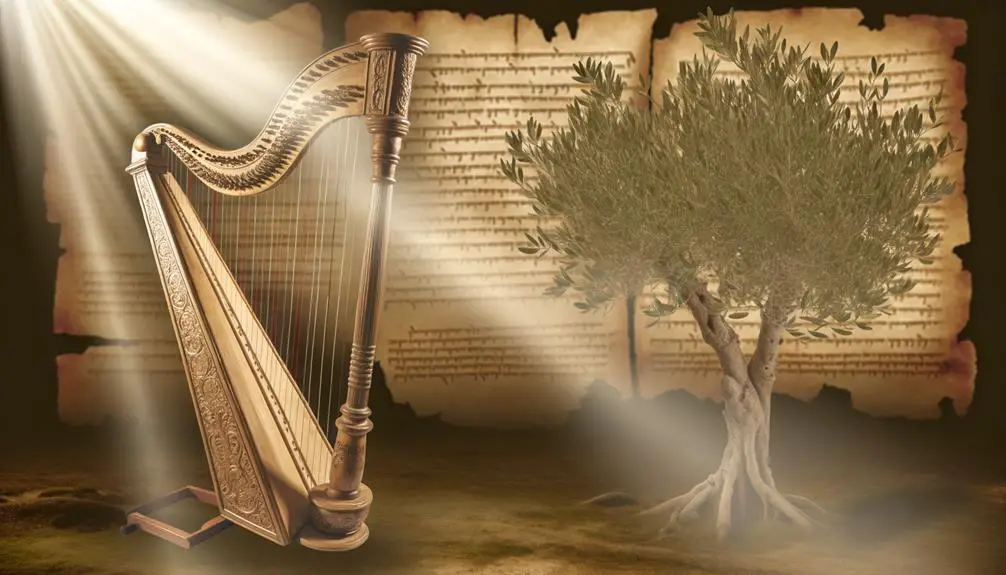
The harp emerges in biblical texts as a significant instrument, deeply intertwined with the cultural and spiritual life of ancient societies. Its construction and the role of ancient harpists are pivotal to understanding its prominence.
You'll find that harp construction in biblical times was a meticulous process, reflecting the instrument's esteemed status. Crafted primarily from wood, the harp was often adorned with precious metals and stones, indicating not just an artistic endeavor but a deeply spiritual one. The strings, made from animal gut, varied in number, influencing the sound and complexity of the music produced.
Ancient harpists held a revered position within their communities, acting as both musicians and storytellers. Their ability to play the harp wasn't merely a skill but a conduit for communication with the divine, for healing, and for bringing communities together during significant events. The harp's soothing tones were believed to have therapeutic properties, calming the soul and facilitating a spiritual connection.
The construction of the harp and the esteemed role of ancient harpists are indicative of the instrument's significance beyond mere entertainment. It served as a bridge between the earthly and the divine, a tool for worship, and a means for preserving and conveying cultural narratives. The harp's biblical origins, therefore, aren't just about the instrument itself but about its impact on ancient societies' cultural and spiritual practices.
This historical context enriches our understanding of the harp's revered place in biblical texts and ancient civilizations.
King David's Harp Legacy
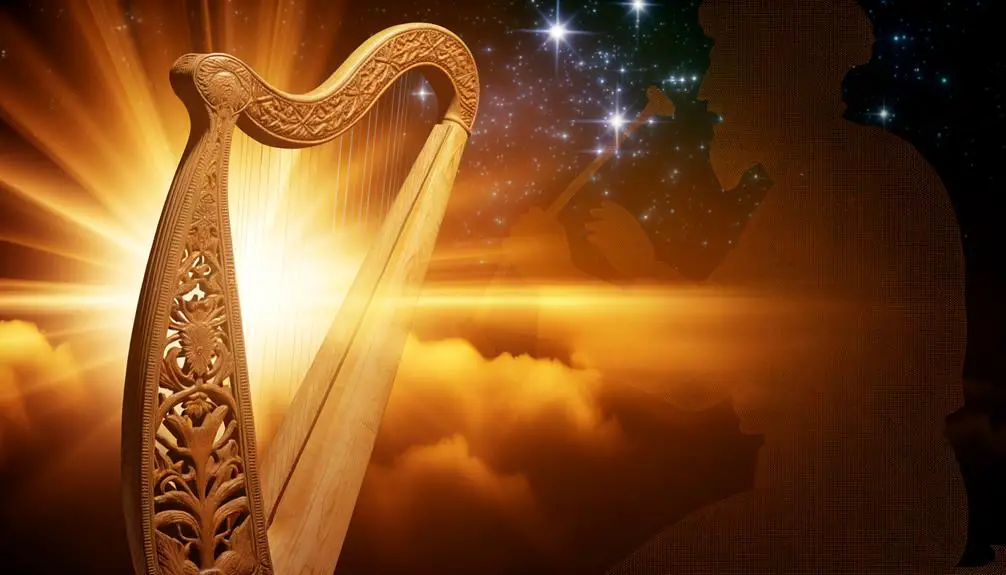
Among the myriad figures in biblical history, King David's mastery of the harp stands out as a profound symbol of spiritual and cultural resonance. David's musicianship isn't just a footnote in his storied life; it's a central theme that underscores his multifaceted legacy. From calming Saul's tormented soul to composing psalms that have echoed through millennia, David's harp is a testament to the power of music in bridging the divine and the human.
To truly appreciate the depth of King David's harp legacy, consider the following points:
- David's introduction to Saul's court was as a harpist, not as a future king or warrior. His skill with the harp was his entry into the biblical narrative, marking the beginning of his rise to prominence.
- Saul's relief upon hearing David play underscores the harp's therapeutic and spiritual significance in ancient times.
- David's musicianship was seen as a divine gift, indicating a direct connection to God which legitimized his rule and endeared him to the people.
- The harp symbolized David's shepherd background, reflecting humility and pastoral calm in the face of royal responsibilities and warfare.
- David's compositions, many of which are attributed to him in the book of Psalms, have influenced religious music and liturgy across centuries.
Analyzing King David's harp legacy reveals not just a historical fascination but a profound appreciation for the power of music to soothe, inspire, and connect humanity to the divine. David's musicianship remains a pivotal element of his enduring influence in religious and cultural narratives.
Symbolism of the Harp
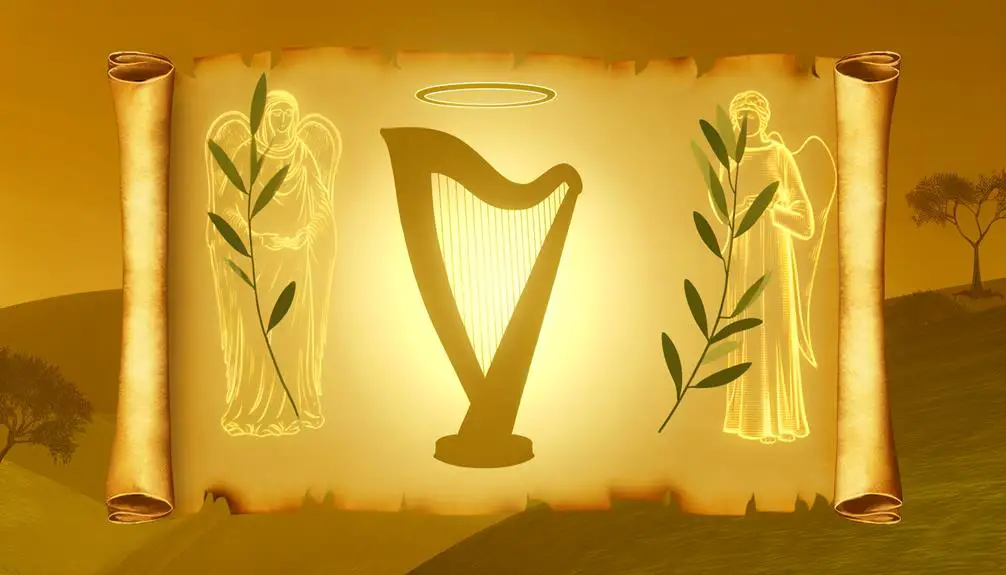
Harps carry deep symbolic weight in biblical contexts, representing not only musical artistry but also divine harmony and spiritual solace. The meticulous harp construction, often detailed in historical texts, signifies the instrument's importance in bridging the earthly with the divine. Crafted from fine woods and sometimes adorned with precious materials, harps weren't just musical instruments; they were artifacts of spiritual significance. Each component, from the strings to the soundbox, was crafted with a purpose, symbolizing the harmony of creation and the meticulous care of the divine craftsman.
Harp players, too, held a significant role in this symbolic landscape. They weren't merely musicians; they were conduits of divine messages, using their art to soothe, inspire, and communicate deeper truths. The biblical narrative often positions harp players as figures of spiritual authority and divine connection, with their music acting as a bridge between the human and the divine.
This symbolism extends beyond the physical aspects of the harp and its players to embody ideals of harmony, peace, and spiritual well-being. In times of trouble, the harp offered solace and hope, its music a balm for the soul. Its presence in sacred texts underscores the instrument's role in fostering an environment conducive to spiritual reflection and communion.
Thus, the harp emerges not just as an instrument of music but as a symbol of divine harmony, a tool for spiritual healing, and a testament to the sacred bond between the creator and creation. Through its construction and the revered status of harp players, the harp encapsulates a profound spiritual symbolism that resonates through biblical history.
Harps in Heavenly Visions
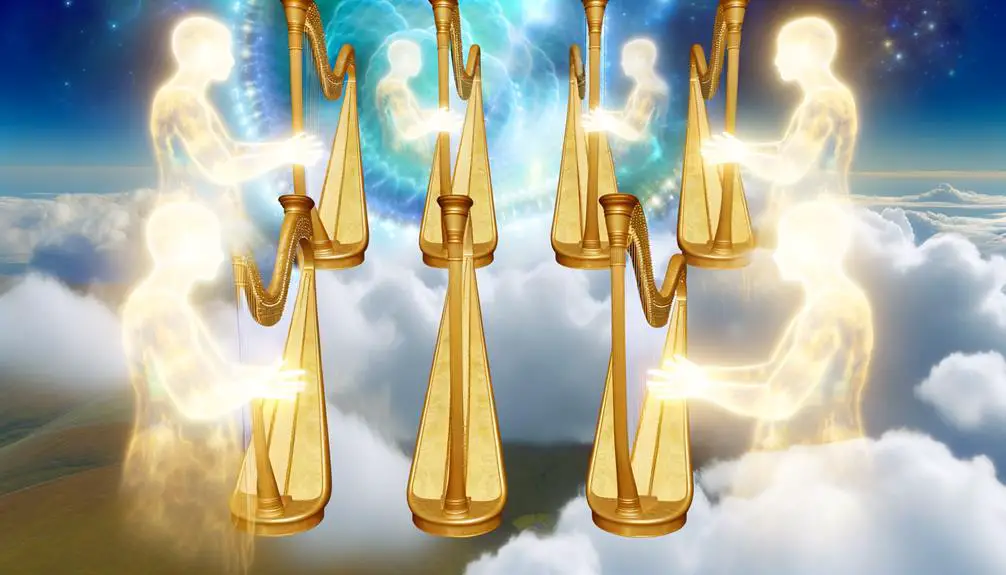
In biblical visions of heaven, harps frequently symbolize the eternal worship and divine music that believers associate with the celestial realm. This imagery isn't accidental but rather deeply imbued with theological significance. The harp, with its soothing tones and complex harmonies, serves as a metaphor for the harmony and beauty of heaven itself. When angelic musicians and heavenly choirs are depicted with harps, it underscores the instrument's integral role in the worship and praise of the divine.
Here are key points to consider:
- The harp's association with angelic musicians emphasizes the ethereal and transcendent nature of heavenly music.
- Heavenly choirs, often accompanied by harps, signify the communal aspect of worship in the afterlife.
- The frequent representation of harps in visions of heaven highlights the instrument's perceived purity and spiritual resonance.
- Harps serve as a bridge between the earthly and the divine, symbolizing the connection between human beings and God through music.
- The portrayal of harps in heavenly visions reinforces the idea of eternal peace and divine harmony, reflecting believers' ultimate aspirations.
The scholarly analysis of harps in heavenly visions reveals a rich tapestry of symbolism and meaning. The instrument not only enhances the aesthetic of these visions but also deepens our understanding of the biblical conception of heaven. By examining the role of harps, we gain insights into the spiritual and theological underpinnings of eternal worship as envisioned in the biblical text.
The Harp's Cultural Impact
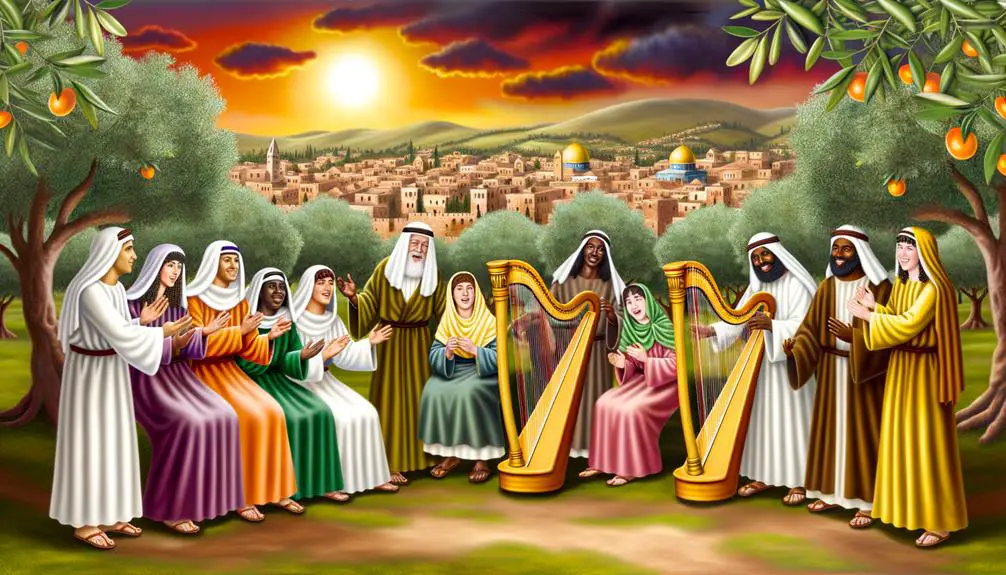
The cultural impact of the harp has resonated deeply through history, shaping artistic expression and societal values across various civilizations. You'll find that this ancient instrument hasn't only survived into modern times but has also undergone significant adaptations, reflecting changes in music's role in society and advancements in technology. These modern adaptations of the harp, from electric versions to innovative designs for increased portability and versatility, showcase the instrument's enduring appeal and its ability to evolve with the times.
Performance practices surrounding the harp have also seen a profound evolution, influenced by both historical context and the cross-pollination of cultural traditions. Traditionally, harpists were often seen as custodians of oral history, their music weaving narratives that spanned generations. Today, you'll observe a blend of these traditional roles with contemporary performance practices, as harpists incorporate a wide range of genres into their repertoire, from classical compositions to jazz and pop arrangements. This fusion of styles not only highlights the harp's versatility but also its capacity to bridge diverse musical traditions, engaging a broader audience.
In analyzing the harp's cultural impact, it's crucial to acknowledge how these modern adaptations and evolved performance practices have contributed to the instrument's sustained relevance. They haven't only ensured the harp's survival but have also enriched our understanding of its potential as a tool for artistic expression. Through this lens, the harp emerges as a symbol of cultural continuity, adapting to the changing landscapes of music and society while retaining its essence and historical significance.
Frequently Asked Questions
How Did the Construction and Design of Harps in Biblical Times Compare to Modern Harps?
When you compare ancient harps to modern ones, you'll notice significant differences in construction and design. Material sourcing has evolved; originally, harps were made from readily available local woods and animal materials, whereas today's harps often incorporate advanced materials for improved sound quality and durability.
Tuning techniques have also advanced, moving from simple manual adjustments to precise mechanical methods, allowing for greater musical accuracy and versatility in contemporary harp performances.
Were There Any Specific Occasions or Ceremonies Outside of the Ones Mentioned in the Bible Where Harps Were Prominently Used in Ancient Israelite Society?
Outside the scope of religious texts, you'll find harps were like the soundtrack to ancient life, especially in Israelite society. They weren't just for worship; their strings sang for military uses and harvest celebrations too.
Imagine the harp's melody rallying soldiers or echoing the joy of a bountiful harvest. This broader usage underscores the harp's versatility and its integral role in both the mundane and the monumental moments of life.
How Did the Skill and Art of Playing the Harp Get Passed Down Through Generations During Biblical Times?
In ancient times, the skill of playing the harp was passed down through generations primarily through family traditions and oral transmission. You'd find that parents and elders would teach the young, ensuring that their cultural and musical heritage continued.
This method of teaching wasn't just about passing on technical skills; it was deeply embedded in their way of life, fostering a strong sense of community and continuity among them.
Are There Any Known Ancient Harp Makers Mentioned in Historical or Biblical Records, and What Was Their Significance?
You're exploring ancient harp makers and their significance, delving into harp symbolism and maker techniques without focusing on biblical contexts.
While specific names of ancient harp makers aren't widely documented, their importance is undeniable.
They crafted instruments that transcended simple music making, embedding cultural and symbolic meanings through their techniques.
This craftsmanship not only showcases their skill but also highlights the deep connection between society, spirituality, and the evolution of musical artistry.
How Does the Depiction of Harps in the Bible Influence Contemporary Music Genres Outside of Religious Contexts?
You'll find that the harp's depiction has significantly influenced contemporary music genres, transcending religious contexts. Its cultural symbolism resonates widely, fostering genre fusion that blends classical with modern elements. This melding enriches music, offering listeners a diverse auditory experience.
The harp's historical and spiritual associations imbue songs with depth, bridging ancient traditions with today's innovative compositions, thus broadening the scope and appeal of music across various audiences.
Conclusion
In wrapping up, you've seen how the humble harp strings together a melodic narrative across the Bible, from David's rockstar gigs to celestial jam sessions.
It's not just an instrument; it's a divine MP3 player, setting the soundtrack of biblical times. The harp, in its ethereal glory, has plucked its way, not just through scripture, but into the cultural psyche, resonating a heavenly vibe.
So, next time you hear a harp, remember, you're tuning into history's greatest hits.

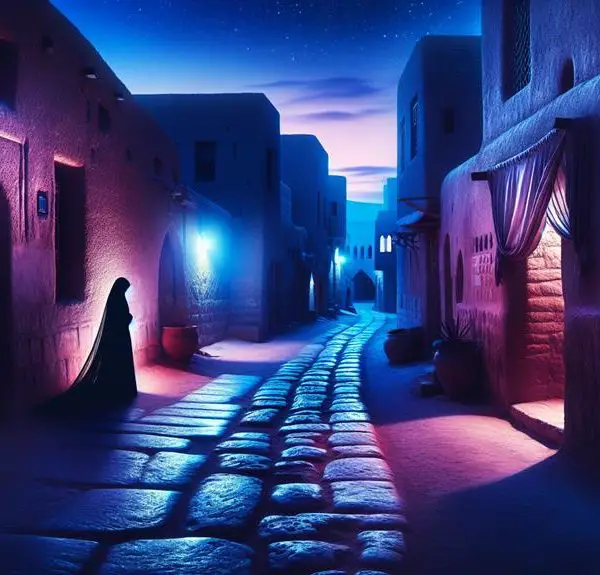

Sign up